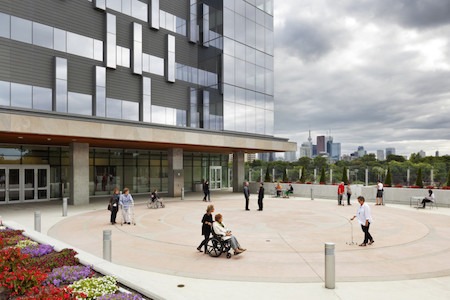
Have you ever heard of generative space? I heard Wayne Ruga talk about it earlier this month at the Healthcare Facilities Symposium in Chicago. Up until then, I’d only read a little about it, but never thought much about generative space.
Ruga’s definition of generative space is “a place — both physical and social — where the experience of the participants in that place is one that both fulfills the functional requirements of that place and it also materially improves the health, healthcare, and/or quality of life for those participating in that experience in a manner that they can each articulate in their own terms.”
Three projects were given the Generative Space Award this year at the Symposium — Bridgepoint Active Healthcare in Toronto, Town Hall Apartments in Chicago, and Humanscale’s Denver office.
I wrote an article about Bridgepoint last year for Healthcare Design. So I talked to many people on the project team. But not one of them mentioned generative space.
One of the architects on the Town Hall Apartments team also confessed to me that they didn’t really design it with generative space in mind either.
Improving Over Time
Does that mean these projects aren’t worthy of a Generative Space Award? Not at all. It just means that the concept of generative space wasn’t the driving force for these projects.
What was, then?
When we first started talking about evidence-based design, healthcare architects told me that it wasn’t anything new — that they had always designed their projects based on past experience and available evidence. I think it is the same for generative space.
In fact, Ruga’s definition of generative space is very similar to the outcomes that a healthcare project designed using an evidence-based design process should achieve. By expanding it across the “full range of life’s contextual situations,” he opens it up to more than just healthcare facilities.
The idea that a generative space is also a place that progressively and tangibly improves over time seems kind of new, though. What healthcare spaces do you know that do this?
Tasking Students to Use Generative Space Concept
For several years, Ruga’s organization, The CARITAS Project, has partnered with the AIA Chicago Healthcare Knowledge Community and Assa Abloy to do a student charrette at the Symposium. This year, five teams were tasked with using the concept of generative space to develop an ambulatory/outpatient/community environment to address behavioral health issues.
Again, in looking at their designs, I see similar concepts that are not just associated with generative spaces. Connection to the community. Access to nature. Sensory stimulation. But something cool is happening by engaging these students to go through this process.
Whether the concept of generative space will ever gain much traction in healthcare is hard to tell. Even though it was introduced in 1999 (about the same time as the term evidence-based design was coined), it’s still relatively new.
What’s your take on it?
P.S. Please do me a favor — if you liked this post and like this blog, please share it with others by sending them the link and/or post it on your Twitter, LinkedIn, or Facebook, etc. Also, don’t forget to subscribe, so you’ll get emails when new content is posted. Thanks!
If you like this post, please share.

What’s my story? I’m a healthcare and senior living design knowledge expert who writes and speaks frequently about trends and issues affecting these two industries. I’m also a strategic marketing consultant and content creator, working with companies and organizations who want to improve the quality of healthcare and senior living through the design of the physical environment. You can reach me at sara@saramarberry.com.


One Response
Thanks for posting this, Sara! Generative Space is much of what therapeutic landscapes in healthcare facilities try to achieve. I’m not talking about healing gardens – those are in a class of their own.
But when we design spaces that are multi-functional, that can provide space for mental restoration AND opportunities for social interaction, for example, then I do consider those designed spaces to be generative space. And designing these spaces with nature actually does transform the space over time, season-by-season as well as year-by-year, so that the dynamic changes within these spaces often change the character and function of the space as well. Yet another reason to include the landscape architect in the Functional Programming of healthcare facilities, well ahead of the design process.
The Sustainable Sites Initiative (SITES) touched on generative design when it incorporated Human Health and Well-being as one of the five components of sustainable site design. By putting people and human health in the environmental equation for sustainability, we raise the bar for a true sustainability – one that addresses not only the impact of the environment on human health, but also how design of the built environment influences population health and community wellness. It opens the door not only for generative space but for regenerative space as well.
So its great to see this aspect of design being acknowledged and rewarded through the Generative Space Award. Kudos to Wayne and his team for raising the bar once again!
Jerry Smith, FASLA, EDAC, LEED AP
SMITH | GreenHealth Consulting